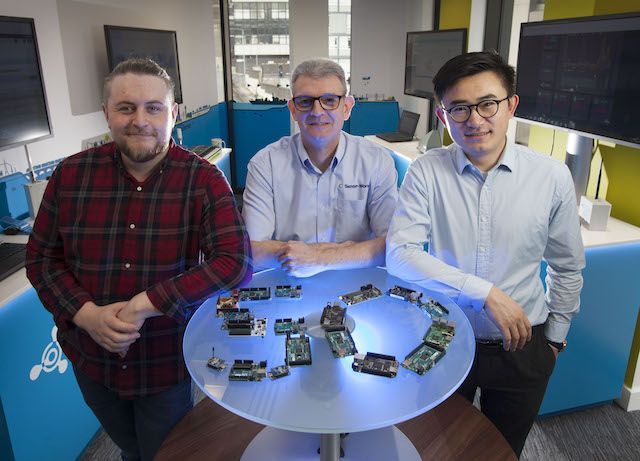
IoT technology set to maximise machine efficiency
- This story was published in The Herald and in a number of other publications in 2017.
A wireless sensor company has developed an IoT -enabled condition monitoring device to help engineers more effectively observe changes in machinery.
The sensor, named BluVib, which was developed by Sensor-Works with assistance from CENSIS, can be fixed to rotating equipment to record vibration and temperature data wirelessly via the IoT.
Connected through Bluetooth to an app on a worker’s handheld device, the sensor provides real-time information about the condition of machines. Currently suitable for use in a range of process industries, such as renewable energy, petrochemicals and oil and gas, the device could soon be used universally in the detection of faults, increased productivity and planned maintenance of machinery.
The product will be used in one of Scotland’s first Industry 4.0 demonstrators at the University of Strathclyde’s Advanced Forming Research Centre (AFRC), part of the High Value Manufacturing Catapult. BluVib will be deployed to measure vibrational signatures on specific machines and the data acquired will be analysed to predict issues, in real-time, relating to machine performance; providing an early indicator of conditions where machine instability can occur.
As well as being a more efficient way to observe changes, it’s also a cost-effective alternative to existing condition monitoring equipment. Through innovative design and manufacturing, Sensor-Works’ product is several times lower cost than current market substitutes, which can range in price from $20,000 to $40,000.
Ian Bain, Managing Director at Sensor-Works, said: “BluVib lets engineers continually assess the health of their machines, allowing them to actively prevent breakdowns and optimise their performance. For example, if you placed a BluVib sensor on the rotating part of a wind turbine, there would be no requirement to regularly climb the turbine to assess its condition. The vibration and temperature data would be logged via the IoT to an engineer’s iPhone or PC, where it could be continually monitored for changes.”
BluVib was created with the help of CENSIS, which helped Sensor-Works mature the product from a proof-of-concept stage. The project is CENSIS’s 50th since its inception in 2013.
Ian continued: “The help from CENSIS has been invaluable in taking our product to the next level. We sat round the table straight away with the engineers, talking about how we could improve and refine BluVib. CENSIS gave us access to specialist technology, and helped us significantly speed up the rate at which the product could be ready for market. CENSIS’ advice and guidance has been a crucial part of the process, and has helped us make inroads with the Advanced Forming Research Centre, with whom we are now working to deploy our BluVib product.”
Ian Reid, CENSIS CEO, said: “Sensor-Works’ adoption of the IoT demonstrates how crucial it could become to a range of businesses looking to streamline their processes and upgrade their product or service offerings. BluVib has huge potential in a number of sectors, particularly in oil and gas and the petrochemicals industries, where maximising efficiency is extremely important for international competitiveness.
“Sensor-Works, our 50th project, is a perfect example of the benefits that the links being forged between Scotland’s world-renowned academic institutions and industrial bases can bring. Working with CENSIS and our IoT Centre, Sensor-Works refined BluVib, making it a much more cost-effective option than other condition monitoring equipment on the market. Sensor-Work’s product could be a game-changer for industry and underlines the opportunities presented by the IoT to SMEs and large business alike.”